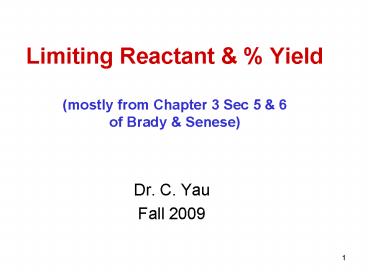Limiting Reactant - PowerPoint PPT Presentation
1 / 13
Title:
Limiting Reactant
Description:
... 40 handles and 40 seats, how many tricycles can we make? ... Example 3.19 p. 114. A chemist set up a synthesis of phosphorus trichloride by mixing 12.0 g of ... – PowerPoint PPT presentation
Number of Views:72
Avg rating:3.0/5.0
Title: Limiting Reactant
1
Limiting Reactant Yield(mostly from Chapter
3 Sec 5 6of Brady Senese)
- Dr. C. Yau
- Fall 2009
2
Limiting Reactant
"Limiting Reactant" refers to the reactant that
limits the amount of product formed. It is the
reactant in shortest supply (based on moles, not
grams).
3
Limiting Reactant
The analogy is manufacturing a tricycle,
requiring 3 tires and 2 handles and 1 seat.
If we have 90 tires, 40 handles and 40 seats, how
many tricycles can we make?
How do you go about answering this question?
4
Limiting Reactant
If we have 90 tires, 40 handles and 40 seats, how
many tricycles can we make?
Here are 2 ways to figure it out 1) Calculate
how many tricycles you can make from 90 tires,
from 40 handles and from 40 seats. The smallest
number of tricycles would be the answer.
4
5
Limiting Reactant
If we have 90 tires, 40 handles and 40 seats, how
many tricycles can we make?
2) The other way is to take 90 tires and
determine how many tricycles can be made, then
see whether there are enough handles. In this
case, 30 tricycles can be made from 90 tires, and
that would require 60 handles, so that tells us
handles may be the limiting factor.
5
6
Limiting Reactant
If we have 90 tires, 40 handles and 40 seats, how
many tricycles can we make?
We now look at the handles 20 tricycles can be
made from the 40 handles, are there enough
seats? From 40 seats we can make 40 tricycles, so
the seats are in surplus, making the handles
still being the limiting factor.
Ans. 20 tricycles
6
7
Limiting Reactant
Example 3.18 p.111 Gold(III) hydroxide is used
for electroplating gold onto other
metals. 2KAuCl4 3Na2Co3 3H2O
2Au(OH)3 6NaCl 2KCl 3CO2 To
prepare a fresh supply of Au(OH)3, a chemist has
mixed 20.00 g of KAuCl4 with 25.00 g of Na2CO3
(both dissolved in a large excess of water). What
is the maximum number of grams of Au(OH)3 that
can be formed?
248.0 g/mol
MM377.9 g/mol
106.0 g/mol
Ans.13.13 g Au(OH)3
Do Practice Exercises 30, 31 p.113
7
8
Percent Yield
"Yield" refers to how much product is obtained,
usually in grams. " yield" refers to the percent
of the theoretical amounts is actually obtained.
LEARN THIS!
Theoretical yield is what we calculate, based on
the balanced chemical equation.
Do not confuse this with error. How does this
fit into part over whole x 100?
8
9
Percent Yield
- If the reaction went perfectly, as expected, the
actual yield would equal to theoretical yield and
yield would be 100. - Reasons why actual yield is often NOT the same as
the theoretical yield - Unavoidable experimental error (some product
cannot be transferred completely from one
container to another.
9
10
Percent Yield
- Reaction may be slow and product was collected
before reaction was finished. - Reaction may be reversible and stops at an
equilibrium rather than going to all products. - Reactants may be impure, of poor quality.
- Reaction may have side reactions where other
products are formed. Thus using up A. - A B
10
11
- Example 3.19 p. 114
- A chemist set up a synthesis of phosphorus
trichloride by mixing 12.0 g of phosphorus with
35.0 g of chlorine gas and obtained 42.4 g of
liquid phosphorus trichloride. calculate the
percentage yield of this compound. - Ans. 93.8 yield
- Do Practice Exercise 32 33 p.115
12
- Example 3.19 p. 114 (continued)
- A chemist set up a synthesis of phosphorus
trichloride by mixing 12.0 g of phosphorus with
35.0 g of chlorine gas and obtained 42.4 g of
liquid phosphorus trichloride. calculate the
percentage yield of this compound. - ADDED QUESTION 1 (similar in homework)
- Which reactant will be left over and how much is
left over?
13
- Example 3.19 p. 114 (continued)
- ADDED QUESTION 2
- A chemist set up a synthesis of phosphorus
trichloride by mixing 12.0 g of phosphorus with
35.0 g of chlorine gas - In this reaction, if the yield is 85.5 how much
phosphorus trichloride should we get? - (In the last problem we determine the theoretical
yield to be 45.2 g.)































